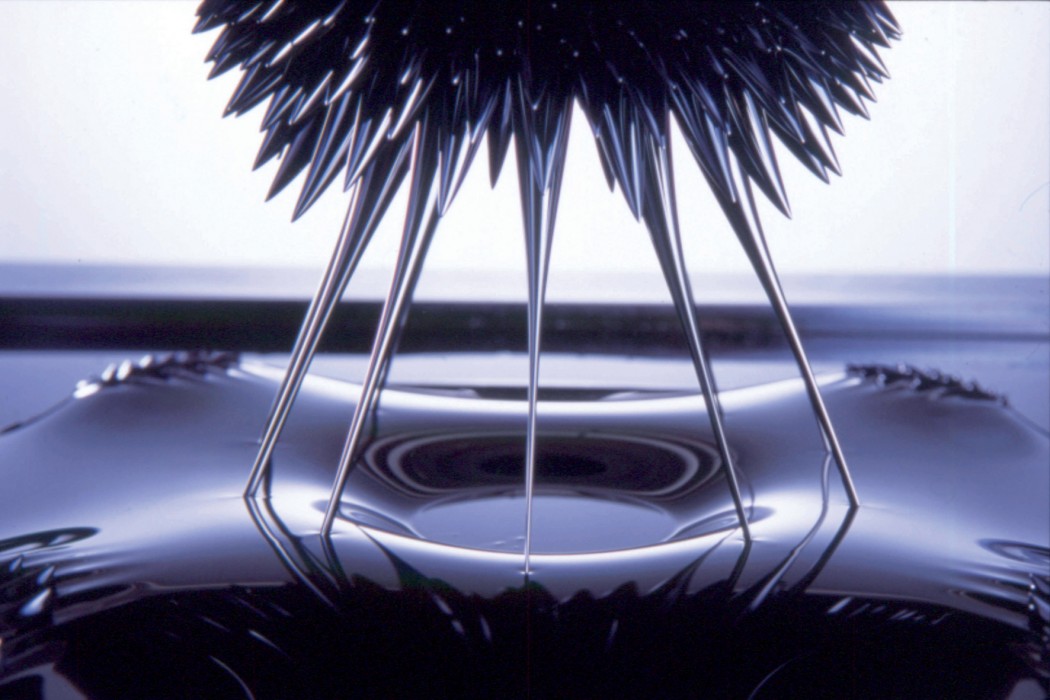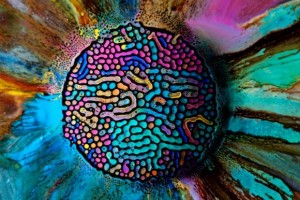Art and science combine themselves yet again in a dazzling way to create a highly conscious work of art that assumes a life of its own when exposed to music. This particular work has no designs of artificial intelligence (the kind that is seen in the film Lucy) but it is essentially a very charismatic invention that enchants the eyes with its spiky and dynamic movement.
Ferrofluid as a concept was invented by NASA in 1963. It was supposed to be used as a liquid rocket fuel. Over the years it has been applied for various mechanical and commercial uses, most commonly in speakers and hard drives. The oily fluid prevents debris from entering hard drives when a small amount is placed between the magnets and the shaft and in case of speakers, they remove heat from the voice coils. It has even been used by doctors for cancer detection.
Photo Courtesy – mono-blog.com
It was only in the 2000’s that this invention was put to an artistic use and accepted for its aesthetic value. It was Sachiko Kodama, a well known Japanese artist who gave alternate life to this technique by pioneering an interactive art project named “Protrude, Flow”. This was created in collaboration with Minako Takeno and was exhibited at the SIGGRAPH 2001 Art Gallery. It was one of the most popular works at the conference.
Photo Courtesy – sachikokodama.com
The art work titled “Morpho Towers–Two Standing Spirals” (2010) by Sachiko Kodama in collaboration with Yasushi Miyajima is another amazing illustration of this particular phenomenon. This is an installation that consists of two Ferrofluid sculptures that move synthetically to music. The two spiral towers stand on a large plate that holds Ferrofluid. When the music starts, the magnetic field around the tower is strengthened. Spikes of Ferrofluid rise up from the bottom plate and move up, trembling and rotating around the edge of the iron spiral. This is just one of their many exquisite works.
If you want a closer glimpse at this marvel, then check out their fascinating youtube video.
Today a lot of artists like Alessandro Brighetti are making use of this technique to give life to their own art work. A Swiss photographer, Fabian Oefner , experimented with Ferrofluid by mixing it with watercolours and placing it over a magnetic field. The results were exquisite and breathtaking.
Photo Courtesy – geek.com
How Does It Work?
Ferrofluid is basically a liquid that, when placed in a magnetic field becomes strongly magnetized which can be attributed to the liquid containing ferromagnetic particles. Ferrofluids are also superparamagnets ( particles in which magnetization only appears due to external influence or temperature), as they don’t remain magnetized once the magnetic field is removed.
Now in the case of Ferrofluidic sculptures the Ferrofluid is placed on a plate which has electromagnetic fields and then music is played to make the fields stronger to combat the force of the liquid‘s own magnetic strength. This in turn causes the liquid to start moving and form stunning spiky shapes. The best part is that the fluid reacts differently to different kinds of music. The spikes are formed by a complex interaction of several forces. The Ferrofluid is attracted to the magnetic field and the magnetic field in turn is attracted to the fluid hence they tear each other into concentrated columns. Gravity tries to pull the columns back down and the surface tension in the oil causes each column to pull in on itself causing the formation of spiky shapes.
Here is a link to a video by Michael Flynn to illustrate the point better.













